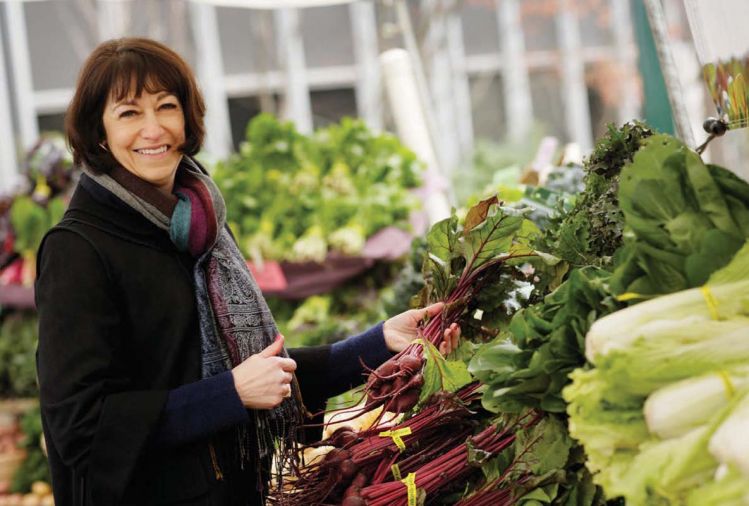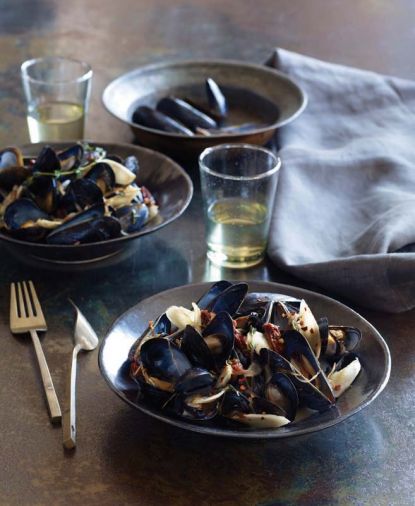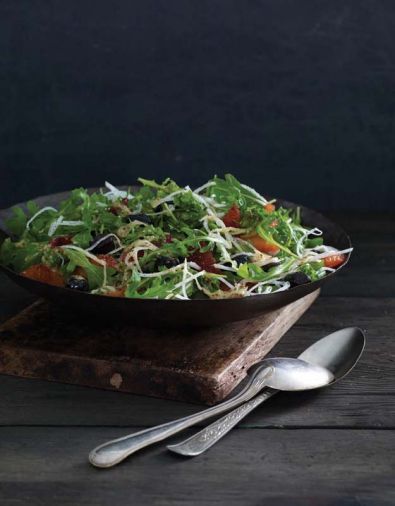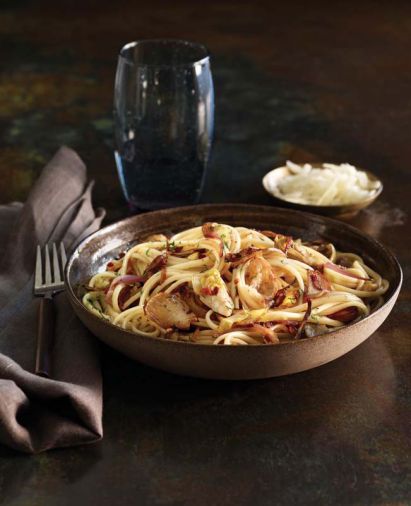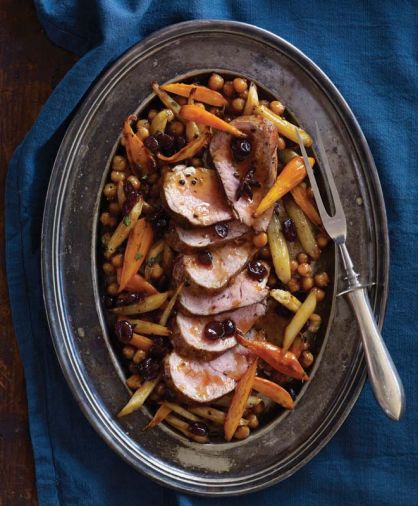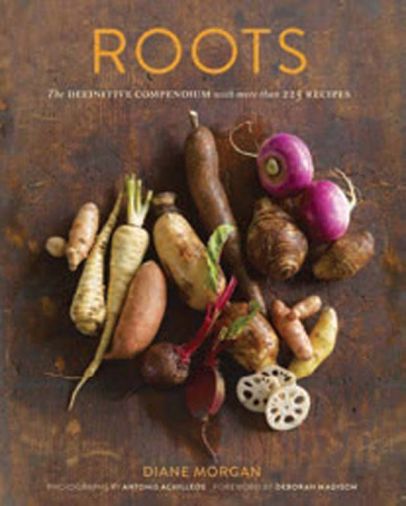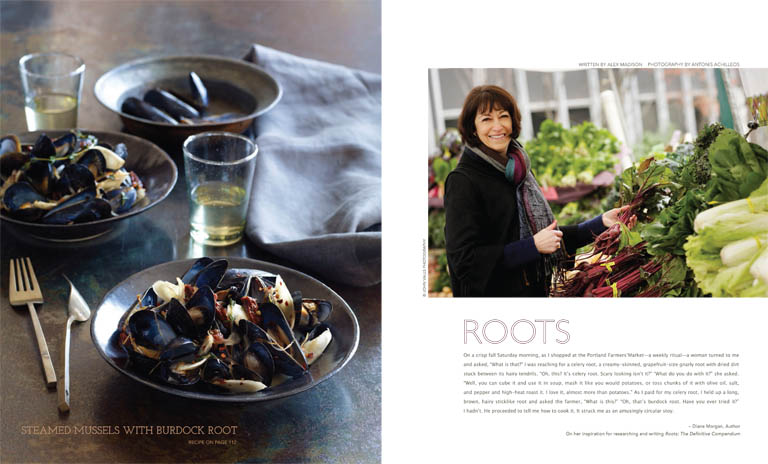On a crisp fall Saturday morning, as I shopped at the Portland Farmers’ Market—a weekly ritual—a woman turned to me and asked, “What is that?” I was reaching for a celery root, a creamy-skinned, grapefruit-size gnarly root with dried dirt stuck between its hairy tendrils. “Oh, this? It’s celery root. Scary looking isn’t it?” “What do you do with it?” she asked. “Well, you can cube it and use it in soup, mash it like you would potatoes, or toss chunks of it with olive oil, salt, and pepper and high-heat roast it. I love it, almost more than potatoes.” As I paid for my celery root, I held up a long, brown, hairy sticklike root and asked the farmer, “What is this?” “Oh, that’s burdock root. Have you ever tried it?” I hadn’t. He proceeded to tell me how to cook it. It struck me as an amusingly circular story.
Most of us have never given the often misshapen appearing root vegetables that appear seasonally at our much-loved local farmers markets and arrive doorstep in our CSA boxes much thought. But as ever curious foodies at heart, after reading Diane Morgan’s Roots: The Definitive Compendium with more than 225 recipes, we were eager to explore the exciting underworld of root vegetables and caught up with author Diane Morgan to learn more about the cookbook, her interest in these subterranean gems and her favorite recipes.
Q: I noticed you have a lot of gourmet recipes along with simple recipes. Tell me a little about your background and inspiration.
In college, I studied mathematics and thought I was going to be an architect. I took a summer job in a restaurant and fell in love with food and had this great mentor and then had a second great mentor at a restaurant up in Fort Townsend, WA that’s no longer there called the Farm House. It was a mobile five-star Jon Conway and his wife opened as sort of a hobby. He was a protégé of James Beard. They were really inspirational forming my palette and broad perspective on food. Sometimes you take a job and then realize that job is something you don’t want to do – I did several of those things. I was a caterer, I was a chef for an executive dining room, I worked in more traditional restaurants and kind of eliminated all those, and then started teaching and writing based on the teaching which ultimately led to having a career in food in a way that was really exciting.
Q: What do you see as some of latest food trends?
We’re seeing a trend that hopefully will be enduring: using vegetables as the center of the plate and making meat a complement – serving fewer ounces of meat and filling the plate with more vegetables, as it should be. There will, of course, always be vegetarians and always be vegans and I don’t think vegans are going to rule the world, but I do think a more heavily focused vegetable diet is kind of the right way to go. It’s certainly how I eat.
Q: Would you say that living in the Pacific Northwest has changed your relationship with roots or your cuisine?
We have this amazing climate for growing root vegetables. Actually 19 out of the 29 roots in the book are grown in the Northwest and I was able to source all of them in Portland. So we just have this great “vegetable basket” so to speak of ingredients and roots are certainly one of them and wherever you shop or care to explore you can find almost everything in the book. That’s pretty great and you can’t say that about most of the rest of the country.
Q: For non root vegetable savvy cooks, what are some of your favorite recipes?
My favorites are Steamed Mussels with Burdock Root, Shallots and Sun-Dried Tomatoes; Jicama and Watermelon Salad with Thai Basil & Pink Peppercorn Vinaigrette; Jerusalem Artichoke Linguine; and Pan-roasted Pork Tenderloin with Salsify, Carrots, Chickpeas, and Cranberries. For dessert, it would be Red Velvet Cupcakes. Beets are a great example for their versatility. They’re a root you can eat both raw or cooked. You can simply roast beets by scrubbing them and taking off the tips and the little tails, and placing them in foil and poking them with holes, then placing them on a baking sheet and into the oven they go. When they’re fork-tender, they’re done, but you also you can also grate them raw and turn them into a slaw. I also turned them into red velvet cupcakes that are the true color instead of using red food coloring.
Jerusalem Artichoke and Artichoke Heart Linguine
(Serves 4 to 6)
Despite their names and their common family, the Jerusalem artichoke and the globe artichoke aren’t at all alike—one is a tuber, the other a thistle. Yet, flavor wise, they relate perfectly in this pasta dish. Add some slivers of red onion, lots of garlic, a kick of red pepper flakes, a squeeze of lemon juice, and a shower of thinly sliced fresh mint and you have a boldly seasoned pasta dish worthy of serving to company yet easy enough for a family meal.
INGREDIENTS
1 tbsp kosher or fine sea salt, plus 1 tsp
1 lb dried linguine
3 tbsp extra-virgin olive oil
1 lb Jerusalem artichokes, cut on the diagonal into slices ¼ in thick
¼ tsp freshly ground pepper
⅛ tsp red pepper flakes
1 small red onion, thinly sliced
One 14-oz can quartered artichoke hearts in water, drained and patted dry
6 large garlic cloves, thinly sliced
1 tsp fresh lemon juice
¼ cup thinly sliced fresh mint
Freshly grated Pecorino Romano cheese for garnish
PREPARATION
Fill a large pot two-thirds full of water, add the 1 tbsp of salt, and bring to a boil over high heat. Add the pasta and stir. Cook the pasta until al dente (cooked through but still slightly chewy), 7 to 8 minutes.
While the pasta water is heating and pasta is cooking, in a large sauté pan, heat the oil over medium-high heat and swirl to coat the pan bottom. Add the Jerusalem artichokes, the remaining 1 tsp salt, the pepper, and red pepper flakes and sauté until the Jerusalem artichokes begin to brown on the edges, about 5 minutes. Add the onion and sauté until translucent, about 5 minutes more. Add the artichoke hearts and garlic and continue sautéing until the artichoke hearts are heated through and the garlic is soft but not brown, about 3 minutes. Add the lemon juice and toss to coat.
When the pasta is ready, drain it in a colander, reserving 1 cup of the cooking water. Add the pasta and the mint to the sauté pan and toss to combine with the Jerusalem artichoke mixture. Add just enough of the reserved pasta water, a little at a time, as needed to moisten. Taste and adjust the seasoning. Divide the pasta among warmed individual bowls and shower with the cheese. Serve immediately.
Steamed Mussels with Burdock Root, Shallots, and Sun-dried Tomatoes
(Serves 3 as a main course, 4 to 6 as a first course)
As it turns out, mussels and burdock root are a natural pairing, delivering an incredibly savory, briny flavor to this dish—a true umami taste. Buy fresh, sweet, plump mussels from a trusted fish purveyor. Once home, spread them out in a large, shallow baking dish, cover them with damp paper towels and then loosely with plastic wrap, and refrigerate until ready to use. I always scrub and debeard the mussels right before I steam them. While you are shopping, buy a loaf of crusty bread for sopping up the delicious sauce.
INGREDIENTS
2 tbsp unsalted butter
4 oz burdock root, scrubbed, trimmed, and cut on a sharp diagonal into slices ⅛ in thick
¾ cup thinly sliced shallots
½ cup drained oil-packed sun-dried tomatoes, blotted dry and cut lengthwise into thirds
2 fresh thyme springs
1 tsp kosher or fine sea salt
¼ tsp red pepper flakes
2 lb mussels, scrubbed and debearded
1 cup dry white wine
¼ cup heavy whipping cream
PREPARATION
In a large, deep frying pan with a tight-fitting lid, melt the butter over medium heat and swirl to coat the pan bottom. Add the burdock root and shallots and sauté, stirring frequently, until the shallots just begin to turn golden brown, 3 to 5 minutes. Add the sun-dried tomatoes, thyme, salt, and red pepper flakes and sauté for 1 minute longer. Increase the heat to medium high and add the mussels and wine. Cover and cook until all of the mussels have opened, about 5 minutes. Uncover the pan and add the cream. Give a quick stir to blend it in, then bring the liquid to a simmer and remove from the heat. Divide the mussels and cooking liquid among warmed bowls, discarding any mussels that failed to open. Serve immediately.
Jicama and Watermelon Salad with Thai Basil and Pink Peppercorn Vinaigrette
Perfect for a summer picnic, buffet, or potluck, this pretty pink salad has floral overtones from the crushed pink peppercorns. You can crush the peppercorns in a mortar with a pestle, or you can put them in a lock-top plastic bag and pound them with a heavy spoon or the side of a rolling pin. Because the watermelon begins to release water once it is mixed with the vinaigrette, this salad is best made no more than 6 to 8 hours before serving.
INGREDIENTS
1 small jicama, about 12 oz, trimmed, peeled, and cut into ½-in cubes
1½ tsp kosher or fine sea salt
¼ cup extra-virgin olive oil
2 tbsp red wine vinegar
1½ tsp pink peppercorns, coarsely crushed
1 small seedless watermelon, about 3½ lb, rind removed and cut into ¾-in cubes
3 tbsp thinly sliced fresh Thai basil
PREPARATION
Toss the jicama with ½ tsp of the salt and place in a colander in the sink to drain for 30 minutes. Blot dry with paper towels. In a large bowl, whisk together the oil, vinegar, pink peppercorns, and the remaining 1 tsp salt. Add the watermelon, jicama, and basil and toss to combine. Taste and adjust the seasoning. Transfer to a serving bowl, cover, and refrigerate until ready to serve. Serve chilled.
Pan-Roasted Pork Tenderloin with Salsify, Carrots, Chickpeas, and Cranberries
INGREDIENTS
4 cups water
½ lemon
1 lb salsify
1 lb carrots
Two 1-lb pork tenderloins, trimmed of fat
Kosher or fine sea salt
Freshly ground pepper
3 tbsp extra-virgin olive oil
½ cup drained canned chickpeas, rinsed and blotted dry
½ cup fresh orange juice
½ cup water
2 tbsp unsweetened dried cranberries
1 tbsp firmly packed light brown sugar
1 star anise pod
¼ tsp pimentón (Spanish smoked paprika)
1 tbsp unsalted butter
1 tbsp finely chopped fresh flat-leaf parsley
1 tbsp finely chopped fresh oregano
PREPARATION
Position a rack in the center of the oven and preheat to 400°F. Pour the water into a bowl and squeeze the juice from the lemon half into the water. Trim and peel the salsify, cut into ¾-in lengths, and immediately drop into the lemon water to prevent discoloration. (If the top of the root is thicker than the tapered bottom, cut the lengths in half lengthwise so they will cook evenly.) Drain the salsify and blot dry with paper towels before sautéing.
Peel and cut the carrots to match the size of the salsify pieces. (If the carrots are thicker at the top, cut the top ends in half lengthwise so they will cook evenly.) Set aside. Season the pork generously on all sides with salt and pepper. Place a 12- in ovenproof sauté pan over medium-high. Add the oil and heat until it shimmers and then swirl to coat the pan bottom. Add the pork tenderloins and sear on all sides until browned and nicely caramelized, about 6 minutes total. Transfer the pork to a large plate.
Add the salsify to the pan and sauté, stirring frequently, for 3 minutes. Add the carrots and continue to sauté, stirring frequently, until the carrots and salsify are browned at the edges, about 5 minutes longer. Add the chickpeas and ½ tsp salt and stir for 1 minute longer. Use a spatula to make two wide channels through the vegetables, and arrange the pork tenderloins, with space between them, in the channels so they rest directly on the pan bottom and the vegetables surround them on all sides.
Place the pan in the oven and roast the pork until an instant-read thermometer inserted into the center of a tenderloin registers 140° to 145°F, about 10 minutes. The center should be rosy when cut into with a knife. Transfer the pork to a carving board and tent loosely with aluminum foil.
Place the pan with the vegetables over medium heat. (Remember that the handle is hot!) Add the orange juice, water, cranberries, brown sugar, star anise, pimentón, and ¼ tsp pepper and mix well. Bring to simmer and cook, stirring occasionally, until the sauce is reduced by half, about 3 minutes. Stir in the butter, parsley, and oregano. Taste and adjust the seasoning.
Cut the pork on a slight diagonal into slices 1 in thick. Arrange a portion of the vegetables in the center of each warmed dinner plate and fan four or five slices of pork over the top. Serve immediately.

